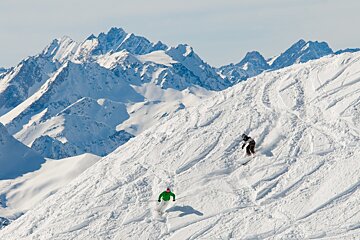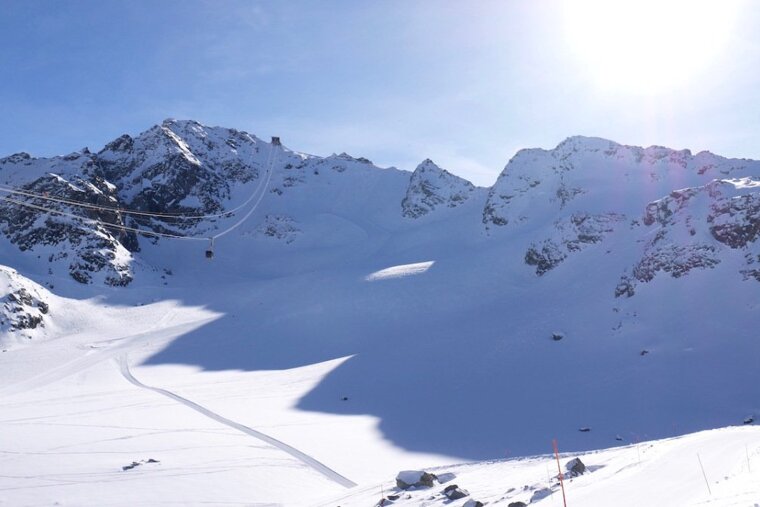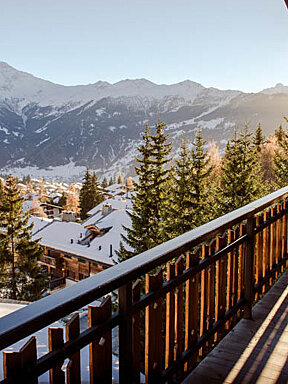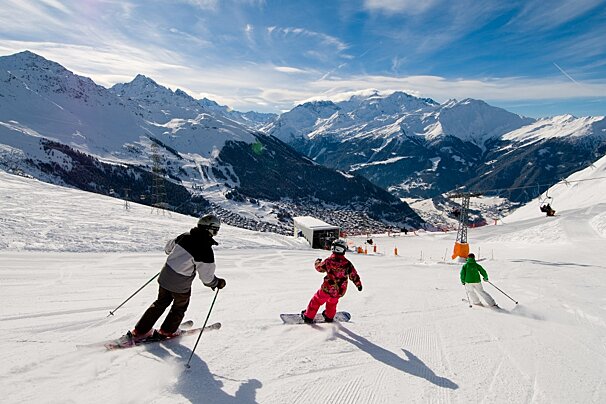
© YGarneau
Off-piste ski areas in Verbier
Discover the top Verbier off-piste skiing
When it comes to off-piste, Verbier is one of the most renowned resorts in the Alps. This is mainly due to the accessibility of its itineraries, as well as numerous possibilities found over an extensive region.
Buy My Ski Pass Book My Ski Hire Book My Mountain Guide
Here are a few suggestions of some of the more popular off-piste itineraries you can do in Verbier & the 4 Valleys.
Watch this

Off-piste skiing in Verbier
Col de Mines
Access to this very popular off-piste run is gained exactly the same way as for the Vallon d’Arbi (see description in La Tzoumaz/Savoleyres section below).
Once you’ve reached the col and dip back onto the “sunny” side, Verbier pops into view and you’re at the start of your run. From there, you can either go straight down, or traverse left or right. Wherever you go, the slope inclination remains a very nice moderately steep grade. If it’s a powder day and you’re amongst the first ones to get there, going straight down is the best & safest bet. As things get tracked out, you can traverse to the skier’s left to get your own fresh track, but the further over you go, the bigger the slope overhead gets, so be very wary of that.
If it’s spring corn you’re after, then you can play with the slope exposure. Depending on how early (or late) it is you might want to traverse left or right. If things are still a bit crunchy at the col, then you’ll want to head to the skier’s right, as the further over you get, the more south-facing the slope gets, and you’ll find the better-transformed snow there. If it’s a bit later in the day, you might want to do the opposite, to avoid overly transformed “soupy” snow. Going straight down is fine too, but if it hasn’t snowed in a long time, you might find it to be a bump run!
No matter which way you choose to go, you will eventually funnel onto the Médran 1 cat track, a blue run which will eventually get bring you all the way down to… Médran!
Col de Mouches
Referred to by the locals as “La Mouche”, this area is easily reached with a high traverse along the top of the Chassoure-Tortin slope. From the top of the Chassoure gondola, go towards the slope everyone calls “Tortin” and remain as high as possible, traversing it to the right (an absolute calf or thigh burner for all you boarders!) When you’ve traversed above the whole face, you’ll cross over into the “Mouche”; a huge open bowl of moderate, consistent steepness. Be careful when crossing over as it is often quite rocky there.
From there, you can either drop straight in (that tends to be tracked out), or traverse the bowl all the way over until you find your own line to carve, which will eventually join up with the flat section at the very bottom of the Gentianes-Tortin itinerary. While doing this, DO remember to keep an eye on the slope above you. Once on the flats, hook a left & you’re minutes away from the lifts at Tortin! Because of its north-eastern exposure, great snow can be found during the winter months, but come the springtime, beware of the “melt-freeze” effect, which can sometimes leave a wicked, very unpleasant crust on the whole bowl.

Off-piste skiing in 4 Vallees & Mont Fort
Backside Mont Fort
Probably the most awesome off-piste itinerary in the 4-Valleys, doing a “backside” means you’re really leaving the ski area boundaries & getting out there in the backcountry for a bit. The slope inclination (very steep at times), glaciated terrain, avalanche potential and relatively long walk out means only expert skiers and snowboarders with a good knowledge of avalanche awareness should attempt this run, or better yet, hire a guide to make sure you go the right way and get out safely!
Access is from the top of the Mont Fort itself. Once you reach the bottom of the tram’s staircase, duck the rope to your left & you’re at the start of your journey. From there, follow the track to the edge of the eastern bowls and drop into the first one. Here, you can either go straight down, or traverse over to the skier’s left and drop into the second bowl. Both are equally as steep, yet the 2nd one is somewhat narrower, but both lead to the same exit zone; your choice. From there, the slope mellows out as you come onto the tongue of the Petit Mont Fort Glacier. Keep your speed through this relatively flat section until you eventually wrap around to the left to tackle a new, short but moderately steep, face. Here you must again keep your speed up as you want to make it as far across the next flat zone (which is actually the frozen Grand Désert Lake). After a bit of pushing, you will reach a section of fun, rolling terrain. At the bottom of this slope, hook a left which will lead you to the start of the traverse above the Cleuson Lake. Although not technically difficult, this traverse is long and necessitates a fair bit of pushing.
When you’ve reached the dam on the lake’s other extremity, you’re on the last leg of your journey. Drop in right next to the dam and make your way down until you hit a road, which you will take to the left. Continue down on it, re-entering the forest, until minutes later, you come out onto the blue Tortin piste which leads down to the 4-man chair in Siviez. Congratulations, you’re back in the 4-Valleys lift system.
Gentianes – Tortin
Probably the easiest off-piste to reach in the entire 4-Valleys, this itinerary gets so much traffic it could be mistaken for a mogulled piste, only days after a snowfall.
From the Col de Gentianes (top of the Jumbo), make your way down towards Tortin on the red piste which makes its way to the bottom of the Glaciers 1 & 2 drag-lifts. Once there, continue past them and you are officially at the start of the Gentianes-Tortin ski itinerary. From there you have different options to make your way down the massive face’s steep sustained gradient. Going skier’s left will take you through some narrower, at times quite steep “couloir like” sections, whilst going skier’s right will take you into a much more open bowl, which can get quite full of moguls, as most people go this way. If unfamiliar with the terrain, going straight down is not recommended, as there are some cliffs to avoid which are difficult to see given the pitch. As you get lower down, every route funnels back to the same central section where speed must be maintained in order to cross the flats and rejoin with the lifts at Tortin!
Because of its northern exposure and higher altitude, the snow can hold quite well in the face, especially on the skier’s left which gets the least sun. Conversely, come springtime and its warmer temperatures, the face can be pretty “bullet-proof” in the mornings… best to wait until the afternoon to hit it.
Stairway to Heaven
Yet another classic itinerary! For the off-piste enthusiast, no trip to Verbier is complete without having carved some turns down “Stairways”… good cold winter powder can often be found right into the spring on this north-facing slope!
Take the Jumbo up to the Col de Gentianes. Make a right when you get down the lift’s stairs and follow the traverse which makes its way towards the large cliffs directly ahead. The traverse will then veer to the right to run parallel to the cliffs. Just after this, if you look up to the left, you will see a boot pack which leads up a relatively wide, steep couloir. This is the “Stairway to Heaven”…
Make your way up (remembering to keep good spacing between riders so as not to load the slope unnecessarily) until you reach the top, some 10 minutes later. Welcome to the start of your run. From here, you can drop in right away, or choose to traverse left along the bowl to get a fresher track. There are no real difficulties to speak of on this moderately sloping open bowl if you keep to the central or left-hand side portion of the glacier. Avoid going to the very right hand side as dependent on the snow-pack depth, the tongue of the glacier is sometimes exposed. To exit, merge towards the left past a hump on the right at the bottom of the face, and then follow the mellow fall-line towards the right until you join up to the lower portion of the Gentianes-Tortin itinerary. Keep your speed up as it gets really flat near the merge point and this will save you some pushing. From there, you’re only minutes away from the lifts at Tortin!

Off-piste skiing in Bruson
Although there are only a handful of actual marked trails (blue, red & black) to choose from, Bruson offers the best tree skiing of the 4-Valleys area.
Most of the good off-piste skiing is found off La Pasay (3-man chair) but Le Grand Tsai (drag-lift), which is sometimes closed due to avalanche danger, offers longer front-side descents back to the bottom of the triple. During snowstorms, it can be bitterly cold and windy on these lifts so make sure you come prepared with warm clothing.
As far as the tree skiing is concerned, pretty much everywhere on the front face goes, with the bigger part of the skiing found in the area between the triple chair and the t-bar. There are however a few flat spots and cliff zones to beware of and avoid. The terrain, which is generally quite moderate, gets progressively steeper as you head away to the skier’s right of La Pasay. Don’t go too far right as there are some avalanche prone clearings and gullies amidst the trees there, not to mention that you’ll miss the cat road bringing you back to the lifts, and have a very unpleasant time bush-whacking your way to the valley floor. This area is entirely off-piste and hazards do exist, so if you decide to head this way, do so with caution and care, and go equipped. It is definitely best to go with someone who knows the area well, perhaps even a guide…
These are merely suggestions of where to go, keeping in mind that off-piste skiing/boarding is always practised at your own risk. Ignoring safety warnings, entering closed areas or ducking under ropes and barriers can have grave consequences in the mountains. This is why we recommend that you take a Verbier mountain guide with you when heading off-piste.
Off-piste skiing in La Tzoumaz & Savoleyres
La Marleinaz
This off-piste “classic” is situated not far from the top of the Savoleyres lift station and can easily be reached with a 15 minute traverse…or an even quicker one from the top of La Tournelle (2-man chair).
From the top of Savoleyres, head along the ridge towards the direction of Pierre Avoi (skier’s right of the bubbles). Continue past the top of La Tournelle and its red run until you reach a huge mountain hump to your left. Make your way past it to the right, and you are officially at the start of La Marleinaz. Follow the big, moderate grade, open bowl down until you reach the tree-line and first few chalets. At this point, start traversing left until you eventually fall onto the Rte de la Marlène which will lead you back towards the bubbles. When you come flush with the Savoleyres lift-line, wind your way down through the chalets until you reach the lift station!
Due to its south-facing exposure, this is an itinerary which should only be attempted in the morning, before the snow has heated up. Usually, unless we’re experiencing a cold snap, it must be hit the first day following a snowfall, as the sun will quickly transform the powder into crud. Also, to avoid a long, annoying walk back to the lift station, make sure the snowline goes down all the way to the village.
Vallon d’Arbi - Ski itinerary [guide recommended] – access from Les Attelas
Lovers of off-piste will revel in this great ski itinerary which is reached from the summit of Les Attelas, en route to the Col des Mines.
Make your way down the Lac des Vaux area keeping on the skier’s left past the 4-man chair (ducking under the rope) until you enter the gully. This moderately pitched gully feeds onto a traverse, which, when not officially open, can be quite hairy as it’s a “no fall zone”, given the cliffs & exposure to the right. When officially open a protected track is carved through the snow making the traverse much more secure. There is also quite a big slope overhead, so you must consider the avalanche risk before entering the traverse.
As early as midway through the traverse (after the cliffs), the Vallon d’Arbi itinerary starts off in an open bowl but quickly enters a section of well spaced big larch trees, making it a pleasure to pull fast, sweeping turns through its moderately steep pitch. For a slightly more exciting run, you can choose to continue traversing right past the Col des Mines & “around the corner”. Slopes there tend to be more loaded, so do take extra care when entering this area & if in doubt: don’t go. Either route you choose will eventually funnel to the same spot at the bottom of the vallon. Once you’ve crossed the stream, a long and at times quite flat cat road eventually brings you to the bottom of the La Tzoumaz bubbles.
Because of the access, which in whiteout conditions can be quite tricky, as well as the risk of avalanche danger given the moderately steep gradient of the slope, it is advisable to always carry with you all pertinent gear, and not to engage in the area when it is closed. Basically, we strongly recommended you hire a guide to bring you safely to this & other great places! If you are up the mountain in the higher alpine areas & the weather suddenly deteriorates leaving you caught in a whiteout, the best thing to do is to head carefully down the mountain as soon as possible. Usually (but not always the case), the lower you get on the mountain, the more the clouds will dissipate and the better the visibility will get. When in “pea-soup” fog, descend the cat roads at a pace which allows you to follow safely (and stay within) the safety markers posted on either side of the trail, thus ensuring you don’t fall off the road.
Before heading off-piste
Before you head off piste, here's a few things you should be thinking about:
- Hire a guide!
- Take a course in avalanche awareness and practice the techniques learned. Henry's Avalanche Talk is one way to find out more with regards avalanche safety and there are several companies who run courses in alpine resorts throughout the winter.
- Look at the weather and avalanche forecasts for France, reviewing the degree of local avalanche risk also. Henry's Avalanche Talk produces a translation of current avalanche conditions in English and PisteHors is also an excellent reference place.
- Don’t ignore advice given by local mountain guides or others if advised to ski a certain path, or to keep a specific distance between fellow members in a group
- Plan the route carefully, evaluating all different options and assessing all elements of danger. Look at the timings for each route. Inform others of your route, and when you expect to arrive back
- Attach your transceiver properly to you and DON'T FORGET to turn it on, test the signal is working, and make sure you have all the necessary equipment. (A transceiver is of no use if the user has not been trained in its use, it is turned off, or it is in a rucksack - unless you want just your bag to be recovered).
Read more about understanding avalanches & how to try to avoid them.
More inspiration...
Take a look at this year's Ski Pass Prices or, if you're not sure which pass to buy, read Ski Pass Options for more information. Find your way around with Piste Maps for Verbier.




























